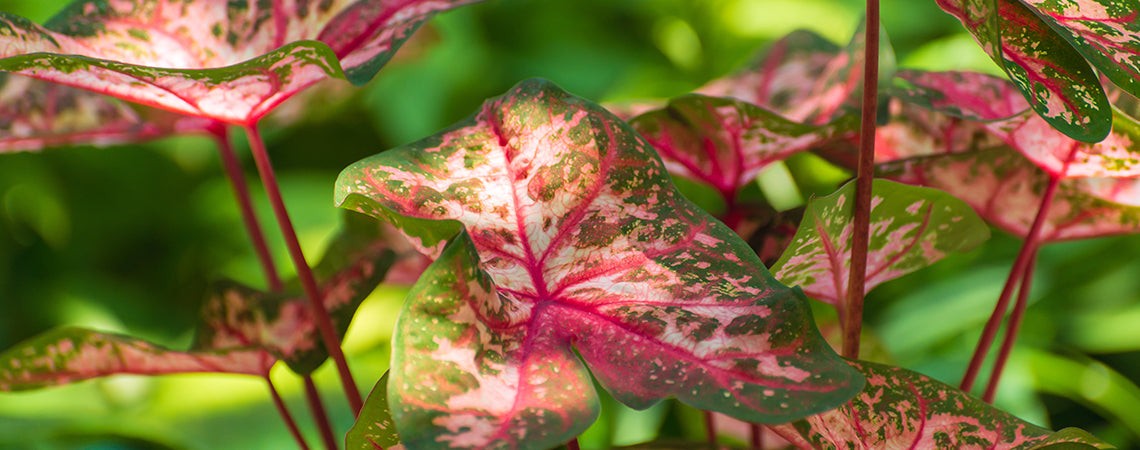Caladiums have surged in popularity in the design world, and it’s easy to see why! These exotic plants boast incredibly detailed and colorful foliage, making them a true spectacle. From speckled and striped varieties to those resembling watermelon slices with pink hues and green edges, each leaf is a unique masterpiece. Whether you’re aiming to cultivate Caladiums indoors as houseplants or in your outdoor garden, this comprehensive care guide will provide you with all the essential tips to maintain their fresh and vibrant appearance.
Indoor Caladium Plant Care
While Caladiums thrive both indoors and outdoors, particularly in warmer climates, their indoor care as houseplants has some specific nuances. Here’s what you need to know to successfully grow them inside:
Sunlight
Just like many tropical plants, Caladiums are sensitive to direct, harsh sunlight. In their natural jungle habitat, they flourish under the protective canopy of taller trees. Therefore, when growing them indoors, aim for bright, indirect light. North or east-facing windows are ideal, offering gentle morning light. If you have a sunnier window, using a sheer curtain to diffuse the intense sunlight is recommended to prevent leaf burn and maintain vibrant colors.
One important aspect of Caladium Care is understanding their dormancy cycle. As daylight hours shorten in the fall and winter, Caladium foliage will naturally die back. This is a normal part of their growth cycle. However, indoors, the growing season can often be extended slightly longer than outdoors. Once the leaves have completely dried out, trim them off using clean pruning shears. At this stage, you have two options: leave the tubers in the pot or carefully dig them up, remove excess soil, and store them in a dry, sealed plastic bag filled with peat moss. In the spring, replant the tubers, and their growth cycle will begin anew.
Water
For indoor Caladiums, watering once a week is generally sufficient. The key is to allow the soil to dry out slightly between waterings. Before adding more water, always check the soil surface; it should be dry to the touch. During the plant’s winter dormancy period, if you choose to keep the tubers in the soil, cease watering completely and allow the soil to remain dry until spring.
Humidity is also crucial for healthy Caladium growth. To increase humidity levels, consider using a small humidifier near your plant, misting it regularly with a spray bottle set to a fine mist, or placing the pot on a pebble tray filled with water (ensuring the pot is above the water line to prevent root rot). It’s also essential to keep your Caladium away from air vents, as the dry air can quickly dehydrate the plant and lead to crispy leaf edges.
Soil and Fertilizing
A high-quality, well-draining all-purpose organic potting mix is perfect for Caladiums. To support their vibrant growth, regular fertilization is beneficial during their active growing season, from April to September. Use a balanced liquid fertilizer diluted to half strength every 2-4 weeks. It’s crucial to avoid fertilizing during the fall and winter months. This resting period is essential for the tubers to store energy and prepare for robust new growth in the spring. Allowing the tubers to rest ensures the next flush of foliage will be as vibrant and impressive as possible.
Growing Caladiums Outdoors
Caladiums are excellent choices for adding dramatic flair to your garden, whether planted in bedding arrangements or containers. Their bold colors and striking patterns bring a touch of exotic beauty and visual interest to any outdoor space.
Sunlight
Careful sunlight management is key for outdoor Caladiums. Since they are sensitive to intense direct sunlight, choosing the right location is crucial. Here are some ideal spots for planting Caladiums outdoors:
- Underneath leafy tree canopies: This provides dappled shade, mimicking their natural habitat.
- Near a North-facing wall or fence: These locations receive minimal direct sunlight.
- Near an East-facing wall or fence: These spots offer gentle morning sun but are shielded from harsh afternoon rays.
- In containers on a shaded patio: This allows for easy relocation if needed to adjust sunlight exposure.
If you notice the leaves of your outdoor Caladiums starting to develop brown, crispy edges, even with consistent watering, it’s a sign they are likely receiving too much sun. For container plants, move them to a more shaded location. For garden beds, you may need to carefully dig up the plants and transplant them to a spot with more shade to protect them from sun scorch.
Water and Soil
Outdoor Caladiums in containers may require daily watering, especially during hot summer months. Caladiums planted directly in garden beds are slightly more drought-tolerant and can be watered less frequently, particularly if you apply a layer of mulch around the plants. Mulch helps retain soil moisture and regulate temperature.
Fertilize outdoor Caladiums monthly from April to September using a balanced fertilizer. As with indoor Caladiums, once the foliage naturally dies back in the fall, trim it off. In regions with mild winters, like California, you can often leave the tubers in the ground over winter if the soil isn’t excessively wet. However, for added protection or in colder climates, many gardeners prefer to dig up the tubers and store them in peat moss over the winter, replanting them in the spring for another season of vibrant color.
By following these Caladium care tips, you can enjoy the spectacular beauty of these tropical plants, both indoors and out, ensuring their foliage remains vibrant and healthy throughout their growing season.
